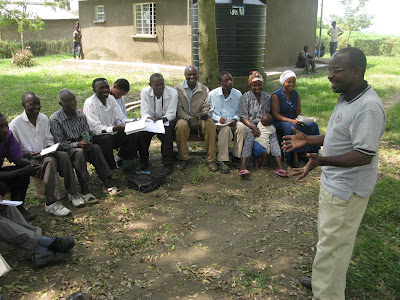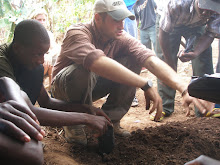 |
| Bwera woman carrying jackfruit and cassava |
 |
| Simon left is in the northern hemisphere, Joukus right, is in the southern, I'm in both! |
Friday and Saturday we packed up in Daniel’s little
car to take our beekeeping trainings down to a village almost exactly on the
equater and very near to the DRC border. It was really good to get out of the noise of town for a while and get
to a rural village. I think the
trainings are off to a good start. Our
group for the past two days was small, about eighteen farmers on average, with people floating in and out. But I was happy, they all seemed serious and I know they all learned something both days. Some were new beekeepers, others were long time traditional beekeepers having anywhere between 5 and 60 traditional fixed comb hives. I was a little disheartened to see that there
was only 2 women, but I was happy to see some very young people in the
mix.
 |
| talking, talking, talking... |
The first day was about 6 hours of me lecturing
with translations. I have to admit I was
a bit exhausted at the end of the day. I talked about the life cycle and biology of bees. That seemed to be the most fascinating for the experienced beekeepers. They asked lots of questions about the nuptial flight of the queen, or the waggle dance of the foragers to indicate the site of a nectar source or a new home in the case of a swarm. Some of it left them dumfounded and laughing, shaking their heads. I smiled and assured them "It's true, I can't make this stuff up. You can read it in bee books." I showed them diagrams of the waggle dance in The Beekeepers Handbook, and asked them to check the next time they see a swarm, "you will see the bees following each other in this same pattern.
 |
| Daniel translating that the drones get kicked out of the hives during the dearth for laziness |
We talked a lot about types of hives. I tried to outline the advantages and disadvantages of both local traditional fixed comb hives (like woven basket hives or log hives), and "modern" movable comb hives like (Kenyan top-bar KTB or langstroth hives). The difference boils down to "intensive beekeeping" vs. "extensive beekeeping."
With intensive beekeeping I mean movable comb hives that can be easily inspected and managed. With intensive beekeeping you can monitor the health of the queen, and growth of the colony by counting the combs of brood. A beekeeper can also make splits and expand his apiary in a controlled way. You can also monitor the ripening of the honey, it is very easy to just take capped honey and leave the rest for the bees. This is the type of beekeeping advocated by most NGOs and visiting beekeepers from the western world.
I think the group was surprised to hear me say that they shouldn't just learn about movable frame hives because NGOs tell them that that they are better and donors are quick to invest in them. They should also make use of the valuable local knowledge in using cheap and easy to manage traditional hives. I might not advocate for fixed comb hives in the US, but here they really make sense. African honey bees (Apis Mellifera Scutellata) are very quick to swarm or abscond so there is always no shortage of bees looking for a hive to occupy. If you bait your hive well, and make it into an ideal space for the bees at the right time of year it will get occupied. Because the African bees move so much their is really no problems with brood diseases.
Most of the traditional hives have an entrance for the bees on one end and removable door on the other side for the beekeeper to enter. The honey is almost always away from the bees entrance, and the brood is up front. If the beekeeper opens from the back and smokes the bees to the front then they can easily focus on just collecting honey from the back and make sure that they don't take comb that is towards the front where brood is, and leave some honey for the bees. I really emphasized that a beekeeper shouldn't be harvesting honey at night as I know many beekeepers do in Malawi, and that they should always take care of the brood nest when possible.
A beekeeper can easily and cheaply build 50 local hives of which probably 35-40 will get occupied. With KTB hives a beekeeper may only be able to afford 5 hives, and the occupation rate would be the same, meaning they would only have 3-4 hives occupied. A beekeeper has a better chance at making a profit by having more inexpensive hives, and they won't be reliant on donors to get started. This is an extensive beekeeping approach. Of course their are cheaper ways to build top bar hives as well, and I encouraged them to be creative in making KTB hives that replace some of the expensive planks with locally available materials, and I gave them some examples of things we did in Malawi. But, mostly I encouraged them to focus on what has already worked in their area, and use the knowledge of local beekeepers.
 |
| The local expert explaining his hive. |
I know that I'm not the expert on local hives so I asked one of the area's long time beekeepers to explain how he makes his traditional hives. He makes it out of bamboo that has elephant grass woven though it to make a long cylinder that narrows at one end. The bees entrance is at the narrow end, and he makes a removable door at the wider end that he seals with cow dung, which he also uses to seal the entire hive. It's simple, practical, proven, and best of all cheap.
 |
| Harvesting from a fixed comb hive |
The second day was mostly practical lessons. First thing in the morning we went out to the hives and visited both a local fixed comb hive, and a KTB hive. I let the owner of the hive take charge as he smoked from the back all of the bee moved towards the entrance, and it was very safe at the back of the hive. The honey was mostly uncapped, so we just took one capped comb so we could do a practical example of honey separating.
 |
| KTB comb with capped honey at the top, then nectar, and capped brood |
Next we went to the KTB hive, for an example of intensive beekeeping. When I opened the hive it was a bit of a mess, there was gaps in between the top bars and some of the bars were too wide, so there was multiple combs on one bar, and others were too small so the comb was attached to the next bar. There was sticks and pieces of grass on top of the bars that were entombed in propolis. We spent some time straightening it out, and removing some of the small top bars. Along the way the participants were able to see drone and worker pupa, larva, eggs, pollen, nectar, and capped honey. It was really great to see how excited some of the more experienced beekeepers were to see the eggs. We put everything back together with no gaps.
Then we went back to the outdoor classroom for practical lessons in separating the honey from the comb. The beekeepers got to see how joukus will check the honey's water content at the LIDEFO before packing. He used the refractometer that was donated by Betterbee Inc. We talked about the importance of storing the honey in airtight white buckets that are kept in a cool dry place to avoid overheating, and moisture getting into the honey. We also talked about the value of the beeswax, and went over different ways to process it.
 |
| Joukus demonstrates the refractometer after we seperated the honey from the comb. |
At the end of the day the chairman read us his report thanking us for the training and we talked about the donated items I told them that they mostly came from a beekeepers association just like theirs in Connecticut, which they really loved. So we decided to make a sign and take a picture thanking their sister beekeepers association in the USA.
 |
| Kyempara Bee Farmers Association Thanking the Connecticut Backyard Beekeepers Association |


1 comment:
Now I know what you meant about fixed comb beekeeping.
Post a Comment